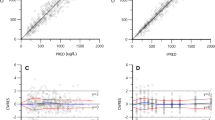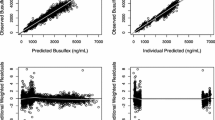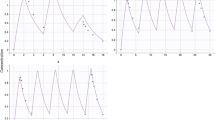Abstract
Background
Busulfan is commonly used in the chemotherapy prior to hematopoietic cell transplantation (HCT). Busulfan has a narrow therapeutic window and a well-established exposure–response relationship with important clinical outcomes. Model-informed precision dosing (MIPD) based on population pharmacokinetic (popPK) models has been implemented in the clinical settings. We aimed to systematically review existing literature on popPK models of intravenous busulfan.
Methods
We systematically searched Ovid MEDLINE, EMBASE, Cochrane Library, Scopus, and Web of Science databases from inception to December 2022 to identify original popPK models (nonlinear mixed-effect modeling) of intravenous busulfan in HCT population. Model-predicted busulfan clearance (CL) was compared using US population data.
Results
Of the 44 eligible popPK studies published since 2002, 68% were developed predominantly in children, 20% in adults, and 11% in both children and adults. The majority of the models were described using first-order elimination or time-varying CL (69% and 26%, respectively). All but three included a body-size descriptor (e.g., body weight, body surface area). Other commonly included covariates were age (30%) and GSTA1 variant (15%). Median between-subject and between-occasion variabilities of CL were 20% and 11%, respectively. Between-model variabilities in predicted median CL were < 20% in all of the weight tiers (10–110 kg) in the simulation based on US population data.
Conclusion
Busulfan PK is commonly described using a first-order elimination or time-varying CL. A simple model with limited covariates were generally sufficient to attain relatively small unexplained variabilities. However, therapeutic drug monitoring may still be necessary to attain a narrow target exposure.


Similar content being viewed by others
Change history
15 March 2024
The original online version of this article was revised to remove the reference text from the Discussion section.
References
D’Souza A, Fretham C, Lee SJ, Arora M, Brunner J, Chhabra S, et al. Current use of and trends in hematopoietic cell transplantation in the United States. Biol Blood Marrow Transplant. 2020;26(8):e177–82.
Palmer J, McCune JS, Perales MA, Marks D, Bubalo J, Mohty M, et al. Personalizing busulfan-based conditioning: considerations from the American Society for Blood and Marrow Transplantation Practice Guidelines Committee. Biol Blood Marrow Transplant. 2016;22(11):1915–25.
Bartelink IH, Lalmohamed A, van Reij EM, Dvorak CC, Savic RM, Zwaveling J, et al. Association of busulfan exposure with survival and toxicity after haemopoietic cell transplantation in children and young adults: a multicentre, retrospective cohort analysis. Lancet Haematol. 2016;3(11):e526–36.
Bartelink IH, van Reij EML, Gerhardt CE, van Maarseveen EM, de Wildt A, Versluys B, et al. Fludarabine and exposure-targeted busulfan compares favorably with busulfan/cyclophosphamide-based regimens in pediatric hematopoietic cell transplantation: maintaining efficacy with less toxicity. Biol Blood Marrow Transplant. 2014;20(3):345–53.
Philippe M, Neely M, Rushing T, Bertrand Y, Bleyzac N, Goutelle S. Maximal concentration of intravenous busulfan as a determinant of veno-occlusive disease: a pharmacokinetic-pharmacodynamic analysis in 293 hematopoietic stem cell transplanted children. Bone Marrow Transplant. 2019;54(3):448–57.
Lawson R, Staatz CE, Fraser CJ, Hennig S. Review of the pharmacokinetics and pharmacodynamics of intravenous busulfan in paediatric patients. Clin Pharmacokinet. 2021;60(1):17–51.
Scian M, Atkins WM. The busulfan metabolite EdAG irreversibly glutathionylates glutaredoxins. Arch Biochem Biophys. 2015;1(583):96–104.
Scian M, Atkins WM. Supporting data for characterization of the busulfan metabolite EdAG and the glutaredoxins that it adducts. Data Brief. 2015;5:161–70.
Scian M, Guttman M, Bouldin SD, Outten CE, Atkins WM. The myeloablative drug busulfan converts cysteine to dehydroalanine and lanthionine in redoxins. Biochemistry. 2016;55(33):4720–30.
Huezo-Diaz P, Uppugunduri CR, Tyagi AK, Krajinovic M, Ansari M. Pharmacogenetic aspects of drug metabolizing enzymes in busulfan based conditioning prior to allogenic hematopoietic stem cell transplantation in children. Curr Drug Metab. 2014;15(3):251–64.
Yuan J, Sun N, Feng X, He H, Mei D, Zhu G, et al. Optimization of busulfan dosing regimen in pediatric patients using a population pharmacokinetic model incorporating GST mutations. Pharmgenomics Pers Med. 2021;14:253–68.
Bubalo J, Carpenter PA, Majhail N, Perales MA, Marks DI, Shaughnessy P, et al. Conditioning chemotherapy dose adjustment in obese patients: a review and position statement by the American Society for Blood and Marrow Transplantation practice guideline committee. Biol Blood Marrow Transplant. 2014;20(5):600–16.
Rhee SJ, Lee JW, Yu KS, Hong KT, Choi JY, Hong CR, et al. Pediatric patients undergoing hematopoietic stem cell transplantation can greatly benefit from a novel once-daily intravenous busulfan dosing nomogram. Am J Hematol. 2017;92(7):607–13.
Takahashi T, Illamola SM, Jennissen CA, Long SE, Lund TC, Orchard PJ, et al. Busulfan dose recommendation in inherited metabolic disorders: population pharmacokinetic analysis. Transplant Cell Ther. 2022;28(2):104.e1–e7.
McCune JS, Quinones CM, Ritchie J, Carpenter PA, van Maarseveen E, Yeh RF, et al. Harmonization of busulfan plasma exposure unit (BPEU): a community-initiated consensus statement. Biol Blood Marrow Transplant. 2019;25(9):1890–7.
Shukla P, Goswami S, Keizer RJ, Winger BA, Kharbanda S, Dvorak CC, et al. Assessment of a model-informed precision dosing platform use in routine clinical care for personalized busulfan therapy in the pediatric hematopoietic cell transplantation (HCT) population. Front Pharmacol. 2020;11(888):888.
Lawson R, Paterson L, Fraser CJ, Hennig S. Evaluation of two software using Bayesian methods for monitoring exposure and dosing once-daily intravenous busulfan in paediatric patients receiving haematopoietic stem cell transplantation. Cancer Chemother Pharmacol. 2021;88(3):379–91.
Neely M, Philippe M, Rushing T, Fu X, van Guilder M, Bayard D, et al. Accurately achieving target busulfan exposure in children and adolescents with very limited sampling and the bestdose software. Ther Drug Monit. 2016;38(3):332–42.
Page MJ, McKenzie JE, Bossuyt PM, Boutron I, Hoffmann TC, Mulrow CD, et al. The PRISMA 2020 statement: an updated guideline for reporting systematic reviews. Syst Rev. 2021;10(1):89.
Centers for Disease Control and Prevention (CDC). National Center for Health Statistics (NCHS). National Health and Nutrition Examination Survey Data. Hyattsville: U.S. Department of Health and Human Services, Centers for Disease Control and Prevention, 2017–2018. [cited January 30, 2023]. https://wwwn.cdc.gov/nchs/nhanes/continuousnhanes/default.aspx?BeginYear=2017.
Kanji S, Hayes M, Ling A, Shamseer L, Chant C, Edwards DJ, et al. Reporting Guidelines for clinical pharmacokinetic studies: the ClinPK Statement. Clin Pharmacokinet. 2015;54(7):783–95.
Langenhorst JB, Boss J, van Kesteren C, Lalmohamed A, Kuball J, Egberts ACG, et al. A semi-mechanistic model based on glutathione depletion to describe intra-individual reduction in busulfan clearance. Br J Clin Pharmacol. 2020;86(8):1499–509.
Trame MN, Bergstrand M, Karlsson MO, Boos J, Hempel G. Population pharmacokinetics of busulfan in children: increased evidence for body surface area and allometric body weight dosing of busulfan in children. Clin Cancer Res. 2011;17(21):6867–77.
Bartelink IH, Boelens JJ, Bredius RG, Egberts AC, Wang C, Bierings MB, et al. Body weight-dependent pharmacokinetics of busulfan in paediatric haematopoietic stem cell transplantation patients: towards individualized dosing. Clin Pharmacokinet. 2012;51(5):331–45.
Bartelink IH, van Kesteren C, Boelens JJ, Egberts TC, Bierings MB, Cuvelier GD, et al. Predictive performance of a busulfan pharmacokinetic model in children and young adults. Ther Drug Monit. 2012;34(5):574–83.
McCune JS, Bemer MJ, Barrett JS, Scott Baker K, Gamis AS, Holford NHG. Busulfan in infant to adult hematopoietic cell transplant recipients: a population pharmacokinetic model for initial and Bayesian dose personalization. Clin Cancer Res. 2014;20(3):754–63.
Wu X, Xie H, Lin W, Yang T, Li N, Lin S, et al. Population pharmacokinetics analysis of intravenous busulfan in Chinese patients undergoing hematopoietic stem cell transplantation. Clin Exp Pharmacol Physiol. 2017;44(5):529–38.
Kawazoe A, Funaki T, Kim S. Population pharmacokinetic analysis of busulfan in Japanese pediatric and adult HCT patients. J Clin Pharmacol. 2018;58(9):1196–204.
Dadkhah A, Wicha SG, Kröger N, Müller A, Pfaffendorf C, Riedner M, et al. Population pharmacokinetics of busulfan and its metabolite sulfolane in patients with myelofibrosis undergoing hematopoietic stem cell transplantation. Pharmaceutics. 2022;14(6):1145.
Ishiwata Y, Nagata M, Tsuge K, Takahashi H, Suzuki S, Imai K, et al. Population pharmacokinetics of intravenous busulfan in Japanese pediatric patients with primary immunodeficiency diseases. J Clin Pharmacol. 2018;58(3):327–31.
van Hoogdalem MW, Emoto C, Fukuda T, Mizuno T, Mehta PA, Vinks AA. Population pharmacokinetic modelling of busulfan and the influence of body composition in paediatric Fanconi anaemia patients. Br J Clin Pharmacol. 2020;86(5):933–43.
Veal GJ, Nguyen L, Paci A, Riggi M, Amiel M, Valteau-Couanet D, et al. Busulfan pharmacokinetics following intravenous and oral dosing regimens in children receiving high-dose myeloablative chemotherapy for high-risk neuroblastoma as part of the HR-NBL-1/SIOPEN trial. Eur J Cancer. 2012;48(16):3063–72.
Wang Y, Kato K, Le Gallo C, Armstrong E, Rock E, Wang X. Dosing algorithm revisit for busulfan following IV infusion. Cancer Chemother Pharmacol. 2015;75(3):505–12.
Paci A, Vassal G, Moshous D, Dalle JH, Bleyzac N, Neven B, et al. Pharmacokinetic behavior and appraisal of intravenous busulfan dosing in infants and older children: the results of a population pharmacokinetic study from a large pediatric cohort undergoing hematopoietic stem-cell transplantation. Ther Drug Monit. 2012;34(2):198–208.
Savic RM, Cowan MJ, Dvorak CC, Pai SY, Pereira L, Bartelink IH, et al. Effect of weight and maturation on busulfan clearance in infants and small children undergoing hematopoietic cell transplantation. Biol Blood Marrow Transplant. 2013;19(11):1608–14.
Poinsignon V, Faivre L, Nguyen L, Neven B, Broutin S, Moshous D, et al. New dosing nomogram and population pharmacokinetic model for young and very young children receiving busulfan for hematopoietic stem cell transplantation conditioning. Pediatr Blood Cancer. 2020;67(10): e28603.
Du X, Huang C, Xue L, Jiao Z, Zhu M, Li J, et al. The correlation between busulfan exposure and clinical outcomes in Chinese pediatric patients: a population pharmacokinetic study. Front Pharmacol. 2022;13.
Alsultan A, Albassam AA, Alturki A, Alsultan A, Essa M, Almuzzaini B, et al. Population pharmacokinetics of busulfan in Saudi pediatric patients undergoing hematopoietic stem cell transplantation. Int J Clin Pharm. 2020;42(2):703–12.
Alsultan A, Albassam AA, Alturki A, Alsultan A, Essa M, Almuzzaini B, et al. Can first-dose therapeutic drug monitoring predict the steady state area under the blood concentration-time curve of busulfan in pediatric patients undergoing hematopoietic stem cell transplantation? Front Pediatr. 2022;10.
Dunn A, Moffett BS, Ivaturi V, Gobburu JVS. Characterization of drug-drug interactions on the pharmacokinetic disposition of busulfan in paediatric patients during haematopoietic stem cell transplantation conditioning. Br J Clin Pharmacol. 2022;88(5):2223–35.
Long-Boyle JR, Savic R, Yan S, Bartelink I, Musick L, French D, et al. Population pharmacokinetics of busulfan in pediatric and young adult patients undergoing hematopoietic cell transplant: a model-based dosing algorithm for personalized therapy and implementation into routine clinical use. Ther Drug Monit. 2015;37(2):236–45.
Lawson R, Staatz CE, Fraser CJ, Ramachandran S, Teague L, Mitchell R, et al. Population pharmacokinetic model for once-daily intravenous busulfan in pediatric subjects describing time-associated clearance. CPT Pharmacomet Syst Pharmacol. 2022;11(8):1002–17.
Ben Hassine K, Nava T, Théoret Y, Nath CE, Daali Y, Kassir N, et al. Precision dosing of intravenous busulfan in pediatric hematopoietic stem cell transplantation: results from a multicenter population pharmacokinetic study. CPT Pharmacomet Syst Pharmacol. 2021;10(9):1043–56.
Sun Y, Huang J, Hao C, Li Z, Liang W, Zhang W, et al. Population pharmacokinetic analysis of intravenous busulfan: GSTA1 genotype is not a predictive factor of initial dose in Chinese adult patients undergoing hematopoietic stem cell transplantation. Cancer Chemother Pharmacol. 2020;85(2):293–308.
Nguyen L, Leger F, Lennon S, Puozzo C. Intravenous busulfan in adults prior to haematopoietic stem cell transplantation: a population pharmacokinetic study. Cancer Chemother Pharmacol. 2006;57(2):191–8.
Johnson L, Orchard PJ, Baker KS, Brundage R, Cao Q, Wang X, et al. Glutathione S-transferase A1 genetic variants reduce busulfan clearance in children undergoing hematopoietic cell transplantation. J Clin Pharmacol. 2008;48(9):1052–62.
Choi B, Kim MG, Han N, Kim T, Ji E, Park S, et al. Population pharmacokinetics and pharmacodynamics of busulfan with GSTA1 polymorphisms in patients undergoing allogeneic hematopoietic stem cell transplantation. Pharmacogenomics. 2015;16(14):1585–94.
Nava T, Kassir N, Rezgui MA, Uppugunduri CRS, Huezo-Diaz Curtis P, Duval M, et al. Incorporation of GSTA1 genetic variations into a population pharmacokinetic model for IV busulfan in paediatric hematopoietic stem cell transplantation. Br J Clin Pharmacol. 2018;84(7):1494–504.
Choe S, Kim G, Lim H-S, Cho S-H, Ghim J-L, Jung JA, et al. A simple dosing scheme for intravenous busulfan based on retrospective population pharmacokinetic analysis in Korean patients. Korean J Physiol Pharmacol. 2012;16(4):273–80.
Huang J, Li Z, Liang W, Chen B, Hu J, Yang W. Accurate prediction of initial busulfan exposure using a test dose with 2- and 6-hour blood sampling in adult patients receiving a twice-daily intravenous busulfan-based conditioning regimen. J Clin Pharmacol. 2019;59(5):638–45.
Salinger DH, Vicini P, Blough DK, O’Donnell PV, Pawlikowski MA, McCune JS. Development of a population pharmacokinetics-based sampling schedule to target daily intravenous busulfan for outpatient clinic administration. J Clin Pharmacol. 2010;50(11):1292–300.
Neely M, Philippe M, Rushing T, Fu X, van Guilder M, Bayard D, et al. Accurately achieving target busulfan exposure in children and adolescents with very limited sampling and the Bestdose software. Ther Drug Monit. 2016;38(3):332–42.
Goutelle S, Woillard JB, Neely M, Yamada W, Bourguignon L. Nonparametric methods in population pharmacokinetics. J Clin Pharmacol. 2022;62(2):142–57.
McCune JS, Navarro SL, Baker KS, Risler LJ, Phillips BR, Randolph TW, et al. Prediction of busulfan clearance by predose plasma metabolomic profiling. Clin Pharmacol Ther. 2023;113(2):370–9.
Zwaveling J, Press RR, Bredius RG, van Derstraaten TR, den Hartigh J, Bartelink IH, et al. Glutathione S-transferase polymorphisms are not associated with population pharmacokinetic parameters of busulfan in pediatric patients. Ther Drug Monit. 2008;30(4):504–10.
McCune JS, Punt AM, Yeh RF, Dupuis LL, Kweekel DM, Franssen EJF, et al. Quality control of busulfan plasma quantitation, modeling, and dosing: An interlaboratory proficiency testing program. Ther Drug Monit. 2021;43(5):657–63. https://doi.org/10.1097/ftd.0000000000000862.
Booth BP, Rahman A, Dagher R, Griebel D, Lennon S, Fuller D, et al. Population pharmacokinetic-based dosing of intravenous busulfan in pediatric patients. J Clin Pharmacol. 2007;47(1):101–11.
Cremers S, Schoemaker R, Bredius R, den Hartigh J, Ball L, Twiss I, et al. Pharmacokinetics of intravenous busulfan in children prior to stem cell transplantation. Br J Clin Pharmacol. 2002;53(4):386–9.
Diestelhorst C, Boos J, McCune JS, Hempel G. Population pharmacokinetics of intravenous busulfan in children: revised body weight-dependent NONMEM® model to optimize dosing. Eur J Clin Pharmacol. 2014;70(7):839–47.
Hempel G, Oechtering D, Lanvers-Kaminsky C, Klingebiel T, Vormoor J, Gruhn B, et al. Cytotoxicity of dimethylacetamide and pharmacokinetics in children receiving intravenous busulfan. J Clin Oncol. 2007;25(13):1772–8.
Neroutsos E, Nalda-Molina R, Paisiou A, Zisaki K, Goussetis E, Spyridonidis A, et al. Development of a population pharmacokinetic model of busulfan in children and evaluation of different sampling schedules for precision dosing. Pharmaceutics. 2022;14(3).
Nguyen L, Fuller D, Lennon S, Leger F, Puozzo CIV. Busulfan in pediatrics: a novel dosing to improve safety/efficacy for hematopoietic progenitor cell transplantation recipients. Bone Marrow Transplant. 2004;33(10):979–87.
Solans BP, Chiesa R, Doncheva B, Prunty H, Veys P, Trocóniz IF, et al. Modelling of neutrophil dynamics in children receiving busulfan or treosulfan for haematopoietic stem cell transplant conditioning. Br J Clin Pharmacol. 2020;86(8):1537–49.
Takama H, Tanaka H, Nakashima D, Ueda R, Takaue Y. Population pharmacokinetics of intravenous busulfan in patients undergoing hematopoietic stem cell transplantation. Bone Marrow Transplant. 2006;37(4):345–51.
Author information
Authors and Affiliations
Corresponding author
Ethics declarations
Funding
Nothing to declare.
Conflict of interest
Nothing to declare.
Ethics approval
Not applicable.
Consent to participate
Not applicable.
Consent to publication
Not applicable.
Availability of data and material
The datasets generated and/or analyzed during the current study are available in the supplementary files.
Code availability
The code used in the current manuscript is available from the corresponding author upon request
Author contributions
TT conceived and designed the study. SJB performed systematic literature search. TT and MMJ performed review the literature and data extraction. TT wrote the manuscript with input from all authors.
Supplementary Information
Below is the link to the electronic supplementary material.
Rights and permissions
Springer Nature or its licensor (e.g. a society or other partner) holds exclusive rights to this article under a publishing agreement with the author(s) or other rightsholder(s); author self-archiving of the accepted manuscript version of this article is solely governed by the terms of such publishing agreement and applicable law.
About this article
Cite this article
Takahashi, T., Jaber, M.M., Brown, S.J. et al. Population Pharmacokinetic Model of Intravenous Busulfan in Hematopoietic Cell Transplantation: Systematic Review and Comparative Simulations. Clin Pharmacokinet 62, 955–968 (2023). https://doi.org/10.1007/s40262-023-01275-x
Accepted:
Published:
Issue Date:
DOI: https://doi.org/10.1007/s40262-023-01275-x




